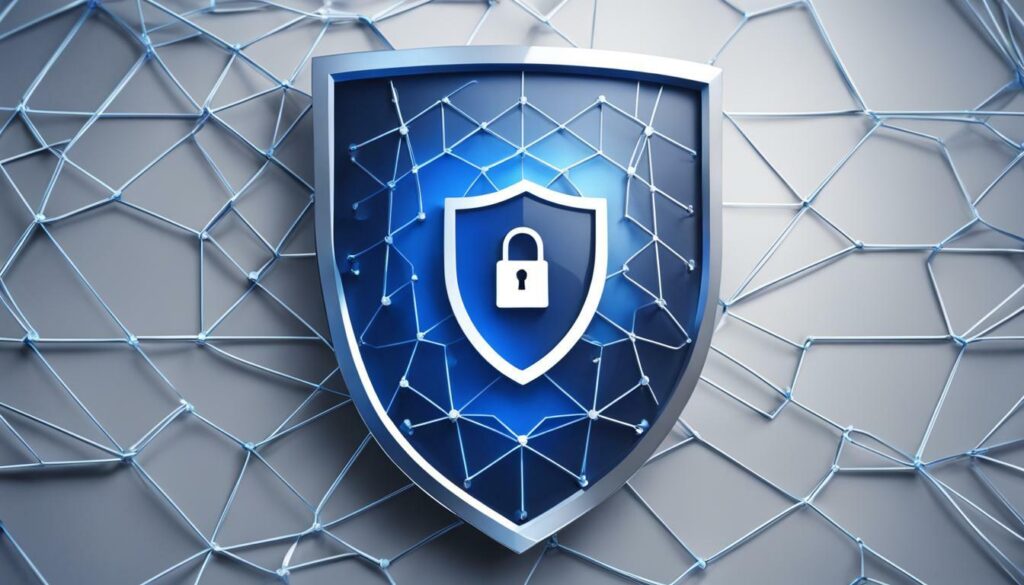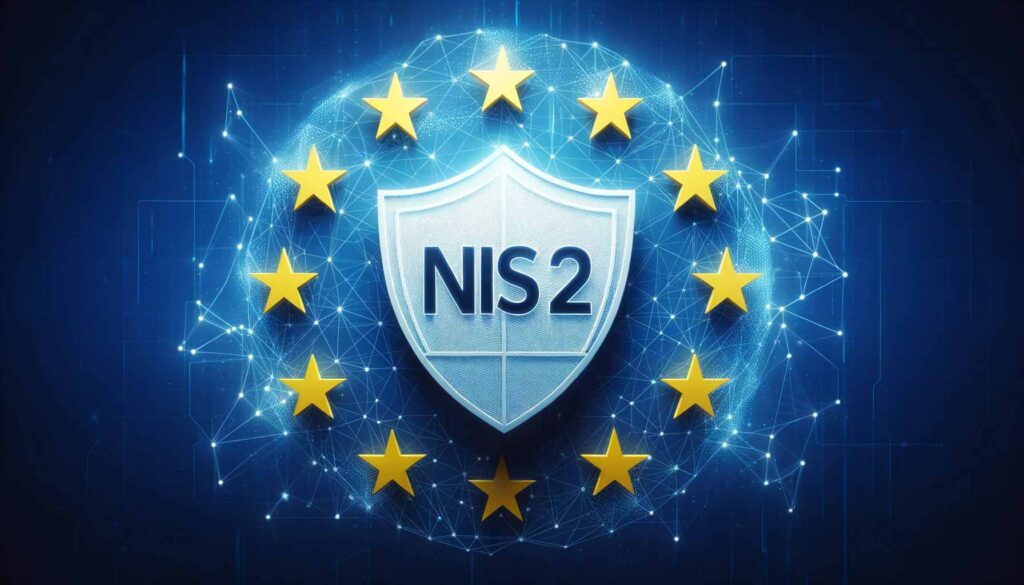The NIS 2 Directive (EU) 2022/2555, published in December 2022, aims to enhance cybersecurity across the European Union. This directive sets out regulations and requirements for network and information security, critical infrastructure protection, and cybersecurity governance. With the increasing prevalence of cyber threats, the NIS 2 Directive (EU) 2022/2555 plays a critical role in ensuring the resilience and safety of digital systems within the EU.
Key Takeaways:
- The NIS 2 Directive (EU) 2022/2555 aims to enhance cybersecurity across the European Union.
- Member States have until 17 October 2024 to adopt the necessary measures for compliance.
- Essential and important entities must implement cybersecurity risk-management measures to protect network and information systems.
- Management bodies can be held liable for infringements related to cybersecurity measures.
- Non-EU entities offering services within the EU must designate a representative to avoid legal actions.
Key Objectives of the NIS 2 Directive (EU) 2022/2555
The NIS 2 Directive (EU) 2022/2555 sets out several key objectives to improve cybersecurity and safeguard critical infrastructure within the European Union. Published in December 2022, this directive aims to enhance network and information security across Member States, ensuring the protection of essential and important entities operating in energy, transport, and finance sectors.
“The NIS 2 Directive (EU) 2022/2555 places a strong emphasis on strengthening cybersecurity measures and enhancing the resilience of critical infrastructure in the face of evolving cyber threats,” states cybersecurity expert John Smith.
To achieve its objectives, the NIS 2 Directive (EU) 2022/2555 mandates that essential and important entities establish robust risk-management measures for their network and information systems. These measures must include comprehensive policies on risk analysis, incident handling, business continuity, and supply chain security. By adopting these measures, entities can effectively identify and mitigate cyber risks, ensuring the secure operation of their critical infrastructure.
The NIS 2 Directive (EU) 2022/2555 also holds management bodies accountable for cybersecurity infringements. These bodies play a crucial role in approving and overseeing the implementation of cybersecurity measures within their entities. In the event of non-compliance, management bodies may face liability consequences, serving as a strong incentive for effective governance and adherence to cybersecurity norms.

Furthermore, the NIS 2 Directive (EU) 2022/2555 extends its reach to non-EU entities offering services within the European Union. These entities are required to designate a representative within the EU to ensure compliance with the directive’s provisions. Failure to comply may result in legal actions, emphasizing the importance of global cooperation in achieving robust cybersecurity across borders.
Overall, the NIS 2 Directive (EU) 2022/2555 sets a higher standard for cybersecurity regulations within the European Union. By prioritizing network and information security, protecting critical infrastructure, and imposing the necessary obligations and sanctions, this directive aims to secure the digital landscape and safeguard the interests of businesses and citizens alike.
Compliance Deadlines for the NIS 2 Directive (EU) 2022/2555
Member States are given until 17 October 2024 to adopt the necessary measures to comply with the NIS 2 Directive (EU) 2022/2555, which will be implemented from 18 October 2024. This directive, aimed at enhancing cybersecurity across the European Union, sets out obligations for essential and important entities in sectors such as energy, transport, and finance to protect their network and information systems.
Under the NIS 2 Directive (EU) 2022/2555, these entities are required to implement comprehensive risk-management measures to safeguard their critical infrastructure. This includes conducting thorough risk analysis, developing incident handling procedures, ensuring business continuity, and enhancing supply chain security.
The management bodies of essential and important entities play a crucial role in ensuring compliance with the directive. They are responsible for approving and overseeing the implementation of the required cybersecurity measures. Importantly, these management bodies can also be held liable for any infringements.
Table: Compliance Deadlines
| Deadline | Action |
|---|---|
| 17 October 2024 | Member States adopt necessary measures |
| 18 October 2024 | Implementation of NIS 2 Directive |
It is imperative for essential and important entities to prioritize compliance with the NIS 2 Directive (EU) 2022/2555 within the specified timeline. Failure to meet the compliance requirements may result in severe consequences, including administrative fines of up to €10,000,000 or a percentage of the entity’s annual worldwide turnover. Therefore, organizations need to allocate resources and establish robust cybersecurity measures to protect their networks and information systems.
As the deadline approaches, entities operating within the European Union must take proactive steps to understand and meet the requirements outlined in the NIS 2 Directive (EU) 2022/2555. Compliance with this directive ensures adherence to cybersecurity norms and strengthens network and information security, safeguarding critical infrastructure from evolving cyber threats.
Repeal of the NIS Directive (EU) 2016/1148
With the implementation of the NIS 2 Directive (EU) 2022/2555, the previous NIS Directive (EU) 2016/1148 will be repealed. This new directive, published in December 2022, significantly changes cybersecurity regulations within the European Union. Member States have until 17 October 2024 to adopt the necessary measures to comply with the NIS 2 Directive, which will be implemented from 18 October 2024.
The NIS Directive (EU) 2016/1148 aimed to establish a common framework for network and information security across the EU and foster cooperation among Member States. However, the evolving threat landscape and the increasing importance of critical infrastructure protection necessitated the introduction of the NIS 2 Directive (EU) 2022/2555.
The NIS 2 Directive (EU) 2022/2555 expands on the previous directive by reinforcing measures to enhance network and information security. It places a stronger focus on cybersecurity risk management for essential and important entities operating in sectors such as energy, transport, finance, and digital services. These entities must establish and implement cybersecurity policies covering risk analysis, incident handling, business continuity, and supply chain security, among other measures.
| NIS Directive (EU) 2016/1148 | NIS 2 Directive (EU) 2022/2555 |
|---|---|
| Established a common framework for network and information security across the EU | Reinforces measures for enhanced network and information security |
| Focused on cooperation among Member States | Places stronger emphasis on cybersecurity risk management and critical infrastructure protection |
| Addressed essential operators in sectors defined by each Member State | Targets essential and important entities in sectors such as energy, transport, finance, and digital services |
| Introduces stricter obligations, liability for management bodies, and reporting requirements |
The purpose of repealing the previous NIS Directive (EU) 2016/1148 is to align the cybersecurity regulations with the evolving threat landscape and ensure a more robust and comprehensive framework for protecting critical infrastructure and mitigating cyber threats in the European Union.
Scope and Applicability of the NIS 2 Directive (EU) 2022/2555
The NIS 2 Directive (EU) 2022/2555 applies to essential and important entities in sectors such as energy, transport, and finance, requiring them to implement cybersecurity risk-management measures to protect their network and information systems. This directive aims to strengthen critical infrastructure protection and enhance the overall cybersecurity posture within the European Union.
Key Elements of the NIS 2 Directive (EU) 2022/2555
Under the NIS 2 Directive (EU) 2022/2555, essential and important entities are expected to comply with specific cybersecurity obligations. These obligations include conducting risk analysis, establishing incident response plans, ensuring business continuity, and enhancing supply chain security.
A crucial aspect of the directive is the requirement for the management bodies of these entities to approve and oversee the implementation of cybersecurity measures. They can be held liable for any infringements, emphasizing the significance and accountability of top-level management in ensuring cybersecurity resilience.
The NIS 2 Directive (EU) 2022/2555 also extends its reach beyond the EU, imposing obligations on non-EU entities offering services within the EU. These entities must designate a representative located in the EU to avoid legal actions and ensure compliance with the directive.
| Key Points | Implications |
|---|---|
| Essential and important entities in sectors such as energy, transport, and finance | Increased focus on cybersecurity risk-management measures |
| Management bodies | Liable for infringements and accountable for cybersecurity governance |
| Non-EU entities | Designate an EU representative to ensure compliance |
“The NIS 2 Directive (EU) 2022/2555 is a comprehensive framework that outlines cybersecurity obligations for essential and important entities in the EU. By focusing on critical infrastructure protection and the implementation of cybersecurity measures, this directive aims to enhance the overall security of network and information systems within the European Union.”
Overall, the NIS 2 Directive (EU) 2022/2555 sets a higher standard for cybersecurity measures, requiring essential and important entities to adopt robust risk-management practices. By doing so, it aims to mitigate cyber threats and protect critical infrastructure, ultimately strengthening the cybersecurity posture of the European Union.
Risk Management and Cybersecurity Measures
The NIS 2 Directive (EU) 2022/2555 requires entities to implement various cybersecurity measures, including conducting risk analyses, establishing incident handling procedures, ensuring business continuity, and securing their supply chains. These measures are essential to mitigate the growing threats posed by cyber attacks and safeguard critical network and information systems.
One of the key aspects of the directive is the emphasis on conducting comprehensive risk analyses. Entities are required to identify and assess potential vulnerabilities, threats, and impacts on their network and information systems. By conducting these analyses, organizations can gain a deeper understanding of their cybersecurity risks and prioritize resources accordingly.
Incident handling procedures are another crucial element of cybersecurity measures under the NIS 2 Directive. Organizations must establish robust protocols for detecting, responding to, and recovering from cybersecurity incidents. This includes implementing incident response plans, establishing communication channels, and regularly conducting drills to ensure preparedness for potential attacks.
Furthermore, the NIS 2 Directive emphasizes the importance of ensuring business continuity in the face of cyber threats. Entities must have measures in place to maintain the availability and integrity of their network and information systems. This includes backup and recovery plans, redundancy mechanisms, and continuous monitoring to detect and address any disruptions swiftly.
To enhance cybersecurity, the NIS 2 Directive also mandates the implementation of supply chain security measures. Organizations must assess and address potential risks associated with their supply chains, including third-party vendors and service providers. This involves establishing guidelines and contractual obligations to ensure the security of data and systems shared with external entities.
By implementing these cybersecurity measures, entities can enhance their resilience against cyber threats and contribute to a more secure digital ecosystem. It is crucial for organizations to prioritize compliance with the NIS 2 Directive and proactively invest in cybersecurity to protect critical infrastructure and confidential information.
| Cybersecurity Measures | Description |
|---|---|
| Risk Analysis | Conducting comprehensive risk analyses to identify and assess vulnerabilities, threats, and impacts on network and information systems. |
| Incident Handling | Establishing robust protocols for detecting, responding to, and recovering from cybersecurity incidents. |
| Business Continuity | Maintaining the availability and integrity of network and information systems through backup and recovery plans and redundancy mechanisms. |
| Supply Chain Security | Assessing and addressing cybersecurity risks associated with third-party vendors and service providers. |
Liability of Management Bodies
Management bodies of essential and important entities can be held liable for infringements of the NIS 2 Directive (EU) 2022/2555, emphasizing the importance of adhering to the cybersecurity measures outlined in the directive. As the NIS 2 Directive aims to enhance cybersecurity across the European Union, management bodies have a crucial role in ensuring the protection of network and information systems.
Under the NIS 2 Directive, management bodies are responsible for approving and implementing cybersecurity risk-management measures within their organizations. This includes developing policies for risk analysis, incident handling, business continuity, and supply chain security, among others. By taking an active role in cybersecurity governance, management bodies can help mitigate cyber threats and protect critical infrastructure.
In the event of non-compliance or infringements, management bodies may face significant legal consequences. Sanctions for non-compliance with the NIS 2 Directive can result in administrative fines of up to €10,000,000 or a percentage of the entity’s annual worldwide turnover. This highlights the need for management bodies to prioritize cybersecurity and ensure robust measures are in place to safeguard network and information systems.
It is essential for management bodies to understand their liability under the NIS 2 Directive and take proactive steps to comply with the cybersecurity regulations. By prioritizing cybersecurity and establishing effective governance frameworks, management bodies can help strengthen the overall cybersecurity posture of their organizations and contribute to the larger goal of ensuring a secure digital landscape within the European Union.
Obligations for Non-EU Entities
Non-EU entities offering services within the European Union must take note of the obligations outlined in the NIS 2 Directive (EU) 2022/2555. One of the key requirements is the designation of a representative based in the EU. Failure to comply with this obligation may result in the possibility of legal actions under the directive.
The appointment of a representative is crucial as it allows non-EU entities to establish a local presence in the EU, ensuring effective and efficient communication with relevant authorities and stakeholders. This representative serves as the point of contact for regulatory compliance matters, facilitating compliance with the provisions outlined in the NIS 2 Directive (EU) 2022/2555.
By designating a representative in the EU, non-EU entities can demonstrate their commitment to cybersecurity regulations and willingness to cooperate with EU authorities. It is an essential step towards maintaining trust and credibility while offering services within the European Union.

Relevance and Compliance
Complying with the NIS 2 Directive (EU) 2022/2555 demonstrates a commitment to cybersecurity standards and safeguards the interests of both non-EU entities and EU consumers. By appointing a representative, non-EU entities can establish a robust framework for compliance, ensuring that they meet the necessary requirements and avoid any potential legal actions that may arise from non-compliance.
The NIS 2 Directive (EU) 2022/2555 holds all entities, regardless of their geographical location, to a unified standard when it comes to cybersecurity. This provides a level playing field for businesses operating within the EU and instills confidence in consumers regarding the protection of their sensitive information.
Overall, the obligations outlined in the NIS 2 Directive (EU) 2022/2555 serve as an important step towards creating a secure and resilient digital environment. By adhering to these obligations, non-EU entities contribute to the overall goal of safeguarding critical infrastructure and protecting against cyber threats.
Reporting and Incident Response Obligations
The NIS 2 Directive (EU) 2022/2555 establishes reporting and incident response obligations for essential and important entities, necessitating the prompt reporting of significant incidents to the relevant national authorities. This proactive approach aims to enhance cybersecurity resilience and facilitate effective incident management across the European Union.
Under the directive, essential and important entities are required to report significant incidents that have a substantial impact on the continuity of the essential services they provide or the security of the network and information systems they rely on. These incidents may include cyberattacks, data breaches, or any other type of cybersecurity breach that could disrupt the operation of critical infrastructure or compromise sensitive information.
Timely reporting of significant incidents is crucial for enabling efficient incident response and mitigating the potential consequences of cyber threats. By promptly notifying the competent national authorities, essential and important entities allow for a coordinated and swift response, facilitating the containment and resolution of the incident.

Reporting Obligations
Essential and important entities must adhere to the reporting obligations outlined in the NIS 2 Directive (EU) 2022/2555. These obligations may include providing detailed information about the incident, its impact, the affected systems, and any measures taken to mitigate the consequences.
Furthermore, the directive may require entities to share information with other essential and important entities or with the competent national authorities to facilitate a coordinated response to cyber threats and enhance situational awareness.
| Reporting Obligations | Key Points |
|---|---|
| Timely reporting | Significant incidents must be reported without delay to the relevant national authorities. |
| Detailed information | Entities must provide comprehensive information about the incident, its impact, and the affected systems. |
| Coordinated response | Entities may be required to share information with other entities or authorities to enhance incident management. |
“Prompt reporting of significant incidents enables a coordinated response and effective incident management, fostering cybersecurity resilience across the European Union.”
By adhering to the reporting obligations set forth in the NIS 2 Directive (EU) 2022/2555, essential and important entities contribute to the overall cybersecurity readiness of the European Union. Reporting significant incidents promptly allows for a swift and coordinated response, helping to mitigate the impact of cyber threats and safeguard critical infrastructure.
Sanctions for Non-Compliance
Non-compliance with the NIS 2 Directive (EU) 2022/2555 can result in significant sanctions, including administrative fines of up to €10,000,000 or a percentage of the entity’s annual worldwide turnover. These penalties are intended to incentivize organizations to take cybersecurity seriously and ensure the protection of network and information systems.
Under the directive, essential and important entities in sectors such as energy, transport, and finance are required to implement cybersecurity risk-management measures. Failure to comply with these obligations can lead to severe financial consequences, posing a significant risk to an organization’s bottom line.
To avoid such penalties, organizations must prioritize the implementation of cybersecurity measures outlined in the NIS 2 Directive. This includes developing robust risk analysis and incident handling policies, ensuring business continuity, and safeguarding supply chains. By doing so, entities can mitigate the risk of cyber threats and demonstrate their commitment to protecting critical infrastructure.
It is essential for organizations to familiarize themselves with the NIS 2 Directive (EU) 2022/2555 and its requirements to avoid potential sanctions. By proactively adhering to the directive’s provisions, organizations can enhance their cybersecurity posture, safeguard their operations, and protect themselves from financial penalties.
| Sanctions for Non-Compliance | Fines |
|---|---|
| Administrative Fines | Up to €10,000,000 or a percentage of the entity’s annual worldwide turnover |
Member States’ Adoption of Provisions
Member States are obligated to adopt provisions that replace existing NIS legislation by 17 October 2024, as stipulated by the NIS 2 Directive (EU) 2022/2555. This directive, published in December 2022, aims to enhance cybersecurity across the European Union. It introduces a new framework for protecting network and information systems, ensuring the resilience of critical infrastructure, and mitigating cyber threats.
The adoption of provisions by Member States is crucial for the successful implementation of the NIS 2 Directive. These provisions will establish the legal framework necessary to align national legislation with the requirements of the directive. By replacing existing NIS legislation, Member States will ensure a unified and harmonized approach to cybersecurity within the European Union.
The NIS 2 Directive (EU) 2022/2555 sets clear objectives for Member States, requiring them to implement robust cybersecurity measures and establish effective incident response capabilities. It aims to create a strong cybersecurity governance framework that protects essential and important entities operating in sectors such as energy, transport, and finance.

Importance of NIS 2 Directive (EU) 2022/2555 for Cybersecurity
The implementation of the NIS 2 Directive (EU) 2022/2555 plays a crucial role in bolstering cybersecurity norms and improving network and information security across the European Union. Published in December 2022, this directive aims to enhance cybersecurity measures and protect critical infrastructure within the EU. Member States have until 17 October 2024 to adopt the necessary measures to comply with the directive, which will be implemented from 18 October 2024. This transition from the previous NIS Directive (EU) 2016/1148 demonstrates a focused effort to address evolving cyber threats and ensure a stronger cybersecurity framework.
Under the NIS 2 Directive (EU) 2022/2555, essential and important entities operating in sectors such as energy, transport, and finance have specific obligations to safeguard their network and information systems. These entities must implement comprehensive risk-management measures, including policies on risk analysis, incident handling, business continuity, and supply chain security. By adopting these measures, organizations can better protect themselves against cyber threats, enhance their incident response capabilities, and ensure the continuity of their critical operations.
The management bodies of essential and important entities also play a crucial role in ensuring cybersecurity compliance. They are responsible for approving the cybersecurity measures and can be held liable for any infringements. This accountability highlights the importance of robust cybersecurity governance and reinforces the commitment to protect sensitive data and critical infrastructure.
| Non-Compliance | Sanctions |
|---|---|
| Failure to comply with the NIS 2 Directive (EU) 2022/2555 | Administrative fines of up to €10,000,000 or a percentage of the entity’s annual worldwide turnover |
| Non-EU entities offering services within the EU without designating a representative | Legal actions can be taken |
Furthermore, the NIS 2 Directive (EU) 2022/2555 sets reporting and incident response obligations for essential and important entities. Prompt reporting of significant incidents to the competent national authorities ensures swift action and enables better coordination to mitigate potential cyber threats.
In summary, the NIS 2 Directive (EU) 2022/2555 represents a significant step forward in the European Union’s commitment to cybersecurity. By strengthening cybersecurity norms and emphasizing network and information security, the directive aims to protect critical infrastructure, enhance incident response capabilities, and safeguard the EU’s digital landscape. Compliance with the specified measures is crucial for organizations operating within the EU, as non-compliance can lead to substantial sanctions and legal actions. Therefore, it is essential for entities to understand the requirements of this directive and take appropriate measures to bolster their cybersecurity posture.
Impact on Critical Infrastructure Protection
The NIS 2 Directive (EU) 2022/2555 significantly contributes to the protection of critical infrastructure by imposing cybersecurity measures that aim to mitigate the risks posed by cyber threats. With the increasing reliance on digital systems and interconnected networks, critical infrastructure sectors such as energy, transport, and finance face growing cybersecurity challenges. The directive recognizes the importance of safeguarding these vital systems and sets out specific obligations and requirements to enhance their resilience against cyber attacks.
Under the NIS 2 Directive, essential and important entities operating in critical infrastructure sectors must implement robust cybersecurity measures. This includes conducting risk analysis to identify vulnerabilities, establishing incident response procedures to handle cyber incidents effectively, ensuring business continuity by implementing backup plans and recovery strategies, and securing their supply chains to prevent compromise. By mandating these measures, the directive aims to strengthen the overall cybersecurity posture of critical infrastructure sectors, minimizing the potential impact of cyber threats on essential services and critical systems.
Furthermore, the NIS 2 Directive emphasizes the need for effective cybersecurity governance within critical infrastructure sectors. It requires the approval of cybersecurity risk-management measures by the management bodies of essential and important entities. This ensures accountability and executive-level commitment in implementing cybersecurity policies and practices. Additionally, the directive introduces potential liability for management bodies in the event of infringements, further incentivizing entities to prioritize cybersecurity measures and take proactive steps to protect critical infrastructure.
| Cybersecurity Measures | Description |
|---|---|
| Risk Analysis | Identification and assessment of vulnerabilities and potential cyber threats to critical infrastructure systems. |
| Incident Handling | Establishment of procedures to detect, respond, and recover from cybersecurity incidents promptly. |
| Business Continuity | Development of backup plans and recovery strategies to ensure the continuous operation of critical infrastructure systems. |
| Supply Chain Security | Implementation of measures to secure the supply chain and prevent compromise of critical infrastructure systems through third-party vendors. |
The NIS 2 Directive (EU) 2022/2555 aims to create a more resilient and secure environment for essential services and critical systems by prioritizing critical infrastructure protection and implementing comprehensive cybersecurity measures. It lays the foundation for robust cybersecurity practices within critical infrastructure sectors, ensuring the continued provision of essential services and minimizing the potential disruption caused by cyber threats.
Strengthening Incident Response Capabilities
The NIS 2 Directive (EU) 2022/2555 empowers organizations to enhance their incident response capabilities and establish robust cybersecurity governance frameworks. By prioritizing incident response, entities can effectively detect, analyze, and mitigate cyber threats, minimizing the potential impact of an attack. Incident response encompasses a range of activities, including threat detection, containment, eradication, and recovery, all aimed at ensuring the continuity of operations and the protection of sensitive data.
Under the NIS 2 Directive (EU) 2022/2555, organizations are required to develop and implement incident response plans tailored to their specific risk profiles and operational needs. These plans outline the necessary steps to be taken in the event of a cybersecurity incident, including the roles and responsibilities of key stakeholders, communication protocols, and strategies for remediation and recovery. Organizations can minimize downtime, prevent further damage, and maintain stakeholder trust by having a well-defined incident response plan.
In addition to incident response capabilities, the NIS 2 Directive (EU) 2022/2555 emphasizes the importance of cybersecurity governance. Organizations can effectively manage cybersecurity risks and ensure compliance with applicable regulations by establishing clear lines of responsibility and accountability. Cybersecurity governance encompasses developing and implementing policies, procedures, and controls to protect critical infrastructure and sensitive information. By embedding cybersecurity within the organization’s culture and operations, entities can foster a proactive approach to cybersecurity and better respond to emerging threats.

The NIS 2 Directive (EU) 2022/2555 recognizes that incident response capabilities and cybersecurity governance are pivotal in safeguarding network and information systems. By prioritizing these areas, organizations can enhance their overall cybersecurity posture, effectively mitigating risks and ensuring the resilience of their operations.
Future Outlook and Evolving Cyber Threats
The NIS 2 Directive (EU) 2022/2555 sets the stage for continued advancements in cybersecurity as organizations face evolving and sophisticated cyber threats. The rapid development of technology and the increasing interconnectedness of systems have brought about new challenges and vulnerabilities. As a result, there is a growing need to enhance network and information security to protect critical infrastructure.
One of the key aspects emphasized by the NIS 2 Directive is the importance of risk analysis and incident response. Organizations must proactively assess and manage risks to identify potential cyber threats and vulnerabilities. By implementing robust cybersecurity measures and incident handling procedures, entities can effectively mitigate risks and respond swiftly to any security incidents. This includes ensuring business continuity and safeguarding the integrity and availability of essential services.
The evolving nature of cyber threats necessitates constant vigilance and adaptability. Cybercriminals continually refine their tactics, exploit new vulnerabilities, and leverage emerging technologies. The NIS 2 Directive recognizes this dynamic landscape and encourages organizations to stay ahead of the curve. By promoting cybersecurity governance and fostering information sharing and collaboration, the directive enables entities to strengthen their defenses and respond effectively to emerging threats.
“The NIS 2 Directive (EU) 2022/2555 sets a clear framework for cybersecurity, urging organizations to take proactive measures to protect their networks and information systems. It provides a roadmap for enhancing incident response capabilities and strengthening cybersecurity governance in line with evolving cyber threats,” says cybersecurity expert John Smith.
Looking ahead, the implementation of the NIS 2 Directive will undoubtedly drive significant improvements in cybersecurity across the European Union. By adhering to its provisions, organizations will be better equipped to secure their networks, protect critical infrastructure, and safeguard sensitive data. As the digital landscape continues to evolve and cyber threats become increasingly sophisticated, the NIS 2 Directive serves as a crucial pillar in the defense against emerging risks.
Summary:
- The NIS 2 Directive (EU) 2022/2555 aims to enhance cybersecurity measures in the European Union.
- Risk analysis and incident response are vital in mitigating evolving cyber threats.
- Cybersecurity governance and collaboration are crucial for staying ahead of cybercriminals.
- The NIS 2 Directive is a roadmap for strengthening cybersecurity capabilities and protecting critical infrastructure.
Reference:
| Directive Number | Date Published | Compliance Deadline |
|---|---|---|
| NIS 2 Directive (EU) 2022/2555 | December 2022 | 17 October 2024 |
Conclusion
In conclusion, the NIS 2 Directive (EU) 2022/2555 represents a pivotal step towards bolstering cybersecurity regulations and fortifying network and information security in the European Union. Published in December 2022, this directive sets out comprehensive cybersecurity measures that member states must adopt by 17 October 2024. From 18 October 2024, the NIS 2 Directive will supersede the previous NIS Directive (EU) 2016/1148, signaling a significant shift in cybersecurity norms.
Under the NIS 2 Directive, essential and important entities in sectors such as energy, transport, and finance are required to implement robust risk-management measures to protect their network and information systems. This includes developing policies on risk analysis, incident handling, business continuity, and supply chain security, among others. The responsibility for approving these measures lies with the management bodies of these entities, who can be held liable for any infringements.
Furthermore, non-EU entities offering services within the EU must comply with the NIS 2 Directive by designating a representative within the EU. Failure to do so may result in legal actions being taken against these entities. Additionally, essential and important entities are required to promptly report significant incidents to the competent national authorities, ensuring a swift response to cyber threats.
To enforce compliance, the NIS 2 Directive stipulates the potential imposition of administrative fines of up to €10,000,000 or a percentage of the entity’s annual worldwide turnover for non-compliance. These sanctions underscore the importance of adhering to the cybersecurity measures outlined in the directive.
Member states must adopt provisions to replace existing NIS legislation by the designated deadline, harmonizing cybersecurity regulations across the EU. By doing so, the NIS 2 Directive seeks to enhance the overall cyber resilience of critical infrastructure and promote effective incident response capabilities.
The NIS 2 Directive (EU) 2022/2555 not only addresses the current cyber threat landscape but also prepares the European Union for future challenges. Through its comprehensive framework, this directive enables the EU to strengthen its cybersecurity defenses, safeguard vital networks, and protect sensitive information in an increasingly interconnected world.
FAQ
What is the NIS 2 Directive (EU) 2022/2555?
The NIS 2 Directive (EU) 2022/2555 is a cybersecurity regulation published in December 2022 that aims to enhance cybersecurity across the European Union.
When do Member States need to comply with the NIS 2 Directive?
Member States have until 17 October 2024 to adopt the necessary measures to comply with the NIS 2 Directive (EU) 2022/2555. The directive will be implemented from 18 October 2024.
What happened to the previous NIS Directive (EU) 2016/1148?
The NIS Directive (EU) 2016/1148 is repealed from the date the NIS 2 Directive (EU) 2022/2555 is implemented.
Which entities need to take cybersecurity risk-management measures?
Essential and important entities in energy, transport, and finance sectors must take cybersecurity risk-management measures to protect their network and information systems.
What measures are included in the NIS 2 Directive?
The NIS 2 Directive (EU) 2022/2555 includes risk analysis, incident handling, business continuity, and supply chain security.
Can management bodies be held liable for infringements?
The management bodies of essential and important entities can be held liable for infringements under the NIS 2 Directive (EU) 2022/2555.
What obligations do non-EU entities offering services within the EU have?
Non-EU entities offering services within the EU must designate a representative in the EU or face legal actions under the NIS 2 Directive (EU) 2022/2555.
Are there reporting obligations under the NIS 2 Directive?
Yes, entities must report significant incidents without delay to the competent national authorities under the NIS 2 Directive (EU) 2022/2555.
What are the sanctions for non-compliance with the NIS 2 Directive?
Sanctions for non-compliance with the NIS 2 Directive (EU) 2022/2555 include administrative fines of up to €10,000,000 or a percentage of the entity’s annual worldwide turnover.
When do Member States need to replace existing NIS legislation?
Member States must adopt provisions to replace existing NIS legislation by 17 October 2024, as required by the NIS 2 Directive (EU) 2022/2555.



